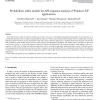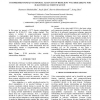205 search results - page 5 / 41 » Detecting algorithmically generated malicious domain names |
PR
2008
13 years 8 months ago
2008
Given the pervasive nature of malicious mobile code (viruses, worms, etc.), developing statistical/structural models of code execution is of considerable importance. We investigat...
ICC
2007
IEEE
14 years 2 months ago
2007
IEEE
—Network Intrusion Detection Systems (NIDS) are more and more important in today’s network security for identifying and preventing malicious attacks over the network. This pape...
WISEC
2010
ACM
14 years 3 months ago
2010
ACM
Computing environments on cellphones, especially smartphones, are becoming more open and general-purpose, thus they also become attractive targets of malware. Cellphone malware no...
ICMCS
2009
IEEE
13 years 6 months ago
2009
IEEE
In this paper we present a DCT domain watermarking approach for H.264/AVC video coding standard. This scheme is resilient to compressed-domain temporal adaptation. A cryptographic...
JDA
2006
13 years 8 months ago
2006
We produce an algorithm that is optimal with respect to both space and execution time to generate all the lozenge (or domino) tilings of a hole-free, general-shape domain given as...


